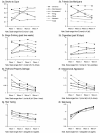Trajectories of Marijuana Use During the Transition to Adulthood: The Big Picture Based on National Panel Data
- PMID: 16534532
- PMCID: PMC1400593
- DOI: 10.1177/002204260503500203
Trajectories of Marijuana Use During the Transition to Adulthood: The Big Picture Based on National Panel Data
Abstract
The purposes of this study were to: a) identify trajectory groups of frequent marijuana use during emerging adulthood, b) distinguish among trajectory groups according to demographic and lifestyle characteristics, and c) examine how the trajectory groups relate to behavioral, attitudinal, and social-emotional correlates over time. National panel data from the Monitoring the Future study were used: 18 cohorts of high school seniors (classes of 1977-94) were followed biennially through age 24. Frequent marijuana use was defined as 3+ occasions of use in past month and/or 20 to 40+ occasions in past year. Based on four waves of complete longitudinal data (N=19,952), six frequent marijuana use trajectory groups were identified: chronic, decreased, increased, fling, rare, and abstain. Categorical analyses revealed trajectory group differences in demographic and lifestyle characteristics at senior year and age 24. The trajectory groups varied significantly in longitudinal patterns of other substance use, problem behaviors, and well-being.
Figures
References
-
- Arnett JJ. Emerging adulthood: A theory of development from late teens through the twenties. American Psychologist. 2000;55:469–480. - PubMed
-
- Bachman JG, O'Malley PM, Schulenberg JE, Johnston LD, Bryant AL, Merline AC. The decline of substance use in young adulthood: Changes in social activities, roles, and beliefs. Lawrence Erlbaum Associates; Mahwah, NJ: 2002.
-
- Bachman JG, Wadsworth KN, O'Malley PM, Johnston LD, Schulenberg JE. Smoking, drinking, and drug use in young adulthood: The impacts of new freedoms and new responsibilities. Lawrence Erlbaum Associates; Mahwah, NJ: 1997.
-
- Bauer DJ, Curran PJ. Distributional assumptions of growth mixture models: Implications for overextraction of latent trajectory classes. Psychological Methods. 2003;8:338–363. - PubMed
Grants and funding
LinkOut - more resources
Full Text Sources
Miscellaneous


